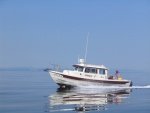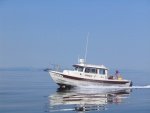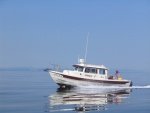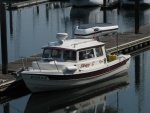hardee":xi9fyiy9 said:
Thanks Bill,
I guess I would hope to be on tha boat and about half way across Juan de Fuca... deep water and far away from shore.
Harvey
SleepyC :moon
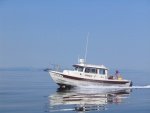
Harvey,
I can tell you a story here of my direct experience with a tidal wave (tsunami).
In 1964 there was a massive earth quake in Anchorage Alaska: C &P quotes here---"On March 27, 1964, at 5:36 p.m. ADT (03:36 3/28 UTC) a great earthquake of magnitude 9.2 (moment magnitude) occurred in Prince William Sound region of Alaska. The epicenter was about 10 km east of the mouth of College Fiord, approximately 90 km west of Valdez and 120 km east of Anchorage. The epicenter was located at Lat. 61.04N, Lon. 147.73W, at a depth of approximately 25 km. This earthquake is the second largest earthquake ever recorded in the world. after a M9.5 earthquake in Chile in 1960. The duration of rupture lasted approximately 4 minutes (240 second
Much of the damage and most of the lives lost were due to the effects of water waves. These were mainly of two kinds: the tsunami of open-ocean sea wave, generated by large-scale motion of the sea floor; and the local wave, generated by underwater landslides in bays of fiords.
The 1964 Alaska tsunami was the second largest ever recorded, again following only the one caused by the 1960 Chile earthquake (4 meters at Sitka). Of the 119 deaths attributable to the effects of the ocean, about one-third were due to the open-ocean tsunami: 4 at Newport Beach, Oregon; 12 at Crescent City, California; and about 21 in Alaska. Local waves claimed at least 82 lives. Maximum height reported for these waves were 70 meters in Valdez Arm".
On that day I was serving as a Marine Eng. on the Canadian coastal passenger and supply ship "SS Canadian Prince". We were north of Prince Rupert by about 20 miles and making a turn to enter the harbour of Port Simpson. I was the watch engineer at that time and the movement of the engine plates indicated flat calm sea conditions. I was always warned from the bridge if heavy wave action was about to start so that I could instruct engine-room staff -and act myself to secure loose gear 'heavy wenches" etc.
Out the blue the ship heeled over to about 15 degrees and some metal objects in the engine room were airborne. That was it "one wave"? I phoned the bridge and said - "what the hell happen"? Their answer was -- "no idea - one wave came at lightning speed out of the NW"? About an hour later we heard the news of the massive earth quake in Alaska-- then later on, the news of Port Alberni, BC being smashed to hell in this tidal wave that swelled up in the Alberni Canal. A few months later I was to work as Mar. Eng. on a salvage tug bundling up tsunami-wave broken boom logs for marine transport down to Chermainus, Van. Isl's. east-coast sawmill. Now I wish I had been on deck to get a sense of the height of that tidal wave and then I might tell you Harvey -yes - or no- as to whether our great Dorys could have survived --LOL. My gut feeling is - probably not - for 2 reasons. The tsunami wave on the open ocean can travel at about 500MPH - I'm told - not high, but fast. You may be hit "unless lucky" on your beam without time to come about-- bow on -- or 2- maybe the wave would just overpower a small boat.
Something to think about ---eh
an old sea-dog --Geoff

